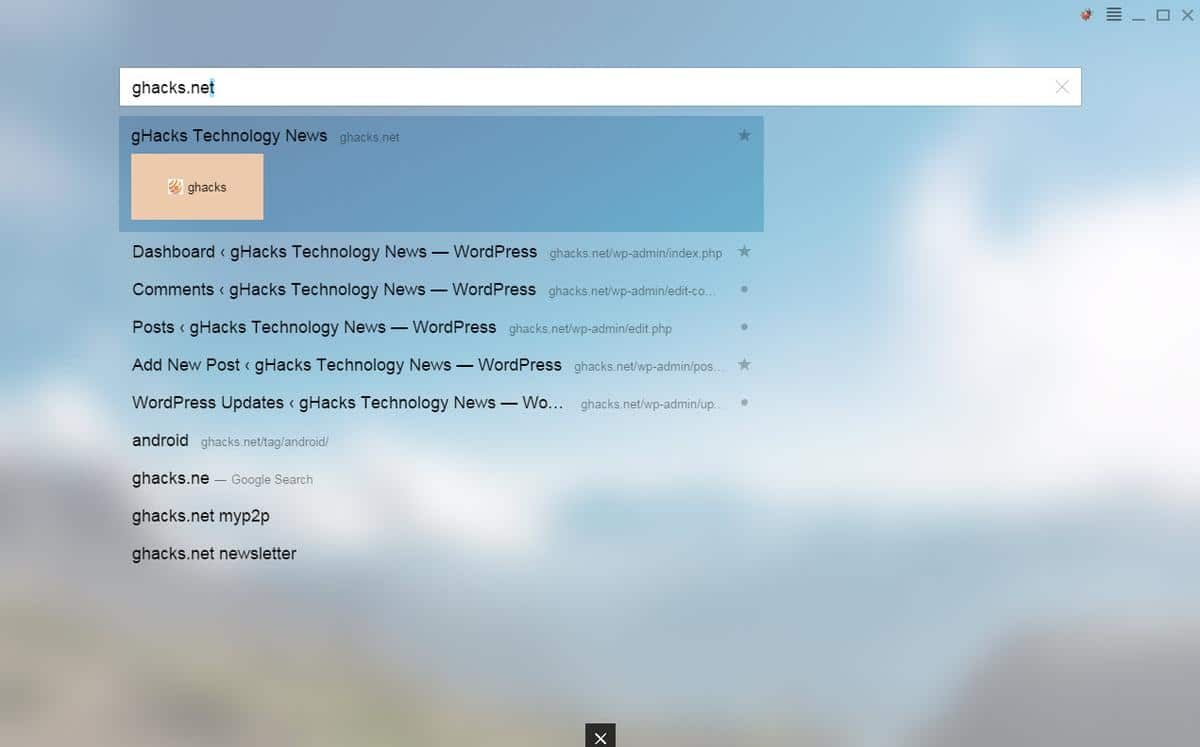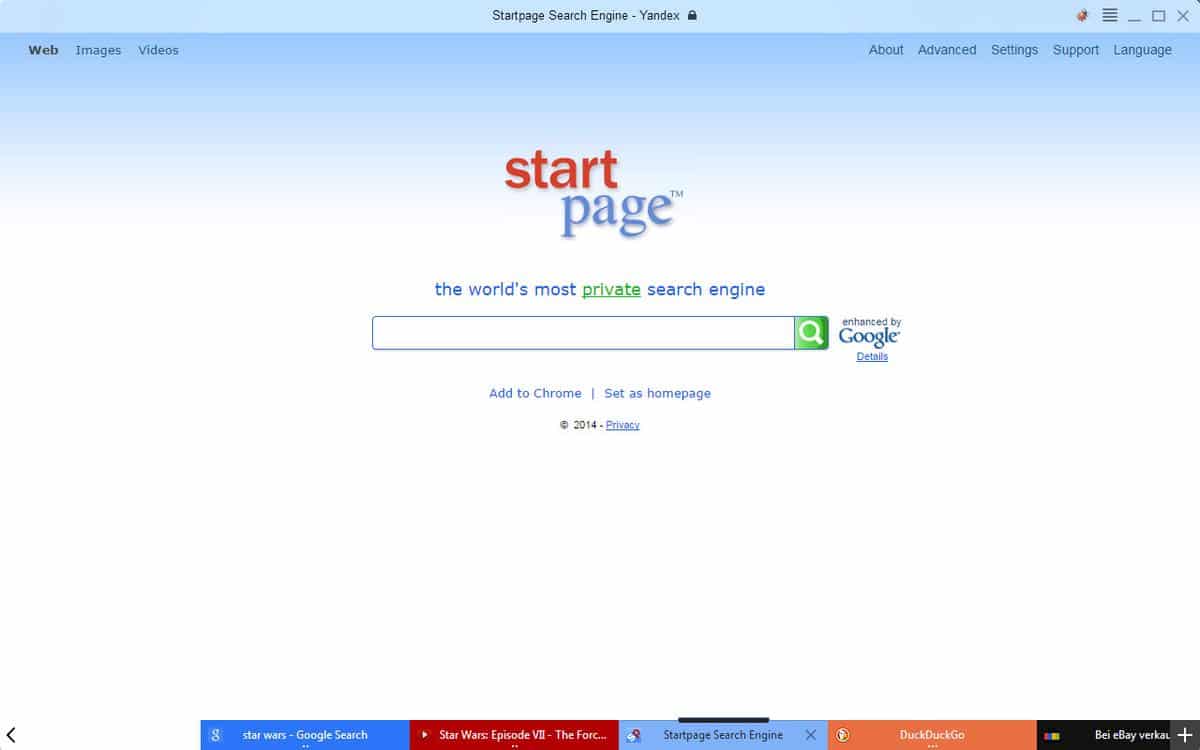- Apr 25, 2013
- 5,356
Minimalism seems to be the trend of the hour, or more precisely, of the past two or three years in the browser world. It started with the release of Google Chrome and its minimalistic design and is still ongoing.
Mozilla for example modified the interface of the Firefox browser this year removing interface elements such as the browser's add-on bar in the process.
Russian search giant Yandex launched a web browser based on Chromium in October 2012 using a slightly modified interface.
An alpha version of the upcoming Yandex browser has been released by the company today.
Note: alpha means that the browser should not be run in a productive environment. It may have bugs, lack features and cause other issues on the system. Also: the browser imported data from Firefox automatically and unless I overlooked it, without option to prevent this from happening.
What's interesting about the release is that Yandex has removed nearly all interface elements. You don't see an address bar on launch for example and tabs are also not visible.
The browser displays a search form on launch and a list of speed dial tiles. Window controls and the main menu icon are at the top right and an x indicates the tab bar at the bottom of the page.
You can sort the tiles using drag & drop operations and switch the background animation as well. There is unfortunately no option to disable it completely but you can turn the animation off.

The search bar on the page appears to function as an address bar as well. You can type or paste an address to load it right away. Suggestions are displayed while you type which work similar to how suggestions work in other browsers and search engines.
When you run a search or load an address directly a tab is displayed at the bottom of the screen. Tabs are colored automatically based on one of the dominant colors of the page that is loaded in them.
Multiple pages of the same website are displayed in the same color and grouped together. Grouping means that they are always opened next to each other and that they are automatically joined when you switch to another tab group.
The effect is that all the pages of that site are displayed as a single tab in the browser interface. When you select them they are displayed individually again.

A feature that the Yandex browser introduces is the ability to switch between the current page and the start page with the click of the mouse. A left-click on the page title flips between both pages. If you are on a supported search site, e.g. on Google, you may also notice that the same search term that you have entered on that site is also entered on the startpage.
The settings reveal additional features of interest. The browser supports a turbo mode that compresses data when enabled including video.
The browser ships with several extensions including Evernote Web Clipper, Last Pass, Web of Trust and Pocket.This and the background animations explain the size of more than 90 Megabyte of the installer.
Other features include options to translate web pages automatically, to use mouse gestures supported by the browser or enable synchronization.
Conclusion
Yandex introduces several interesting features in the browser. Automatic tab grouping for example or the ability to switch between the startpage and the current page.
It seems pretty fast and responsive as well.
It is on the other hand different than the majority of browsers that you come across which many users won't like for one reason or the other.
Experienced users may dislike the lack of control it offers. There does not seem to be a way to display the current url for example.
Source
Mozilla for example modified the interface of the Firefox browser this year removing interface elements such as the browser's add-on bar in the process.
Russian search giant Yandex launched a web browser based on Chromium in October 2012 using a slightly modified interface.
An alpha version of the upcoming Yandex browser has been released by the company today.
Note: alpha means that the browser should not be run in a productive environment. It may have bugs, lack features and cause other issues on the system. Also: the browser imported data from Firefox automatically and unless I overlooked it, without option to prevent this from happening.
What's interesting about the release is that Yandex has removed nearly all interface elements. You don't see an address bar on launch for example and tabs are also not visible.
The browser displays a search form on launch and a list of speed dial tiles. Window controls and the main menu icon are at the top right and an x indicates the tab bar at the bottom of the page.
You can sort the tiles using drag & drop operations and switch the background animation as well. There is unfortunately no option to disable it completely but you can turn the animation off.

The search bar on the page appears to function as an address bar as well. You can type or paste an address to load it right away. Suggestions are displayed while you type which work similar to how suggestions work in other browsers and search engines.
When you run a search or load an address directly a tab is displayed at the bottom of the screen. Tabs are colored automatically based on one of the dominant colors of the page that is loaded in them.
Multiple pages of the same website are displayed in the same color and grouped together. Grouping means that they are always opened next to each other and that they are automatically joined when you switch to another tab group.
The effect is that all the pages of that site are displayed as a single tab in the browser interface. When you select them they are displayed individually again.

A feature that the Yandex browser introduces is the ability to switch between the current page and the start page with the click of the mouse. A left-click on the page title flips between both pages. If you are on a supported search site, e.g. on Google, you may also notice that the same search term that you have entered on that site is also entered on the startpage.
The settings reveal additional features of interest. The browser supports a turbo mode that compresses data when enabled including video.
The browser ships with several extensions including Evernote Web Clipper, Last Pass, Web of Trust and Pocket.This and the background animations explain the size of more than 90 Megabyte of the installer.
Other features include options to translate web pages automatically, to use mouse gestures supported by the browser or enable synchronization.
Conclusion
Yandex introduces several interesting features in the browser. Automatic tab grouping for example or the ability to switch between the startpage and the current page.
It seems pretty fast and responsive as well.
It is on the other hand different than the majority of browsers that you come across which many users won't like for one reason or the other.
Experienced users may dislike the lack of control it offers. There does not seem to be a way to display the current url for example.
Source